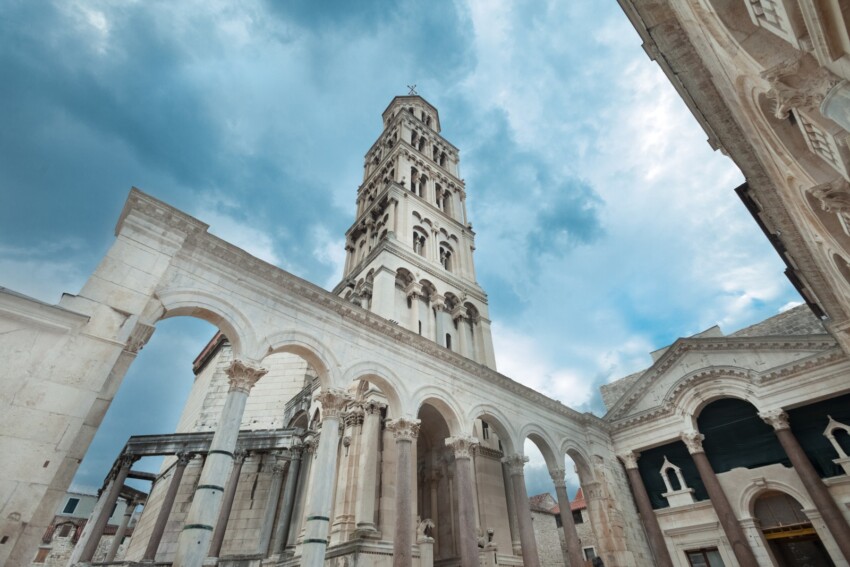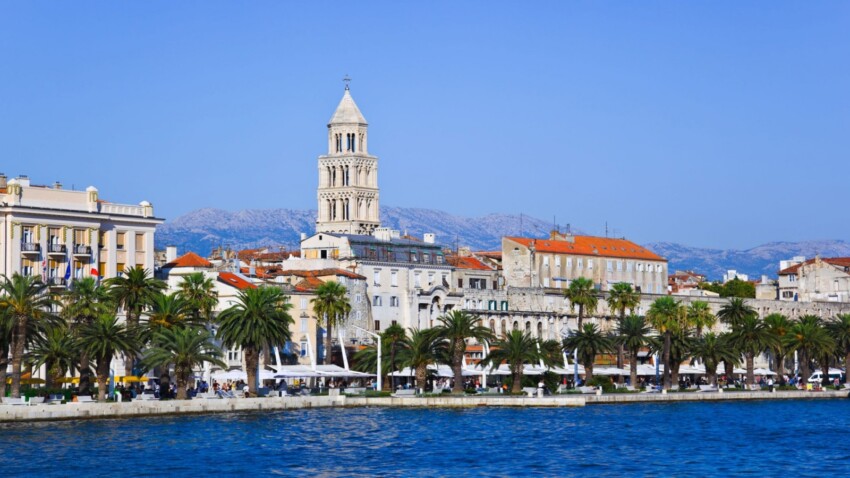

Split is Croatia’s second largest city and an essential stop on an on-the-road holiday in south-central Dalmatia.
It is certainly worth a stop to visit the splendid Diocletian’s Palace, a small city within a city built of fine white stone that creates a striking contrast with the colour of the sea.
The beaches are nearby and easily accessible, but Split has the appeal of a city rather than a seaside resort.
Stroll through the elegant streets of the centre and along the waterfront and take advantage of the many cultural tourism opportunities Split has to offer, with its prestigious festivals, international film and theatre events and traditional folk festivals.
Splendid by day, when the sun goes down Split turns into the queen of the night, with a wide choice of pubs, clubs and discos where you can party till late.

Split’s most famous attraction is Diocletian’s Palace: overlooking the harbour, it is a magnificent example of Roman architecture. Although it has undergone many changes over time, it has retained its ancient charm and is still well preserved.
Despite its name, do not expect to visit a palace consisting of a single building. Diocletian’s Palace is more like a small citadel consisting of two intersecting streets, forming four separate areas.
Its original function was a mixture of imperial residence and military fortress; today there are more than 200 buildings inside the palace, many of them inhabited or used as shops, bars or restaurants.
Built with beautiful white Brac stone and other precious marbles, creating a striking contrast with the blue sea in the background, Diocletian’s Palace is a labyrinth in which it is a pleasure to wander for hours, exploring every nook and cranny.
Four fortified gates open along the palace’s perimeter walls: Golden Gate, Bronze Gate, Silver Gate and Iron Gate. These are not their original names: it was the Venetians who named each gate after a metal.
A smaller part that opens along the living section of the imperial palace leads to the sea.

For the people of Split, the peristyle of Diocletian’s Palace is the centre of Split and the world. It is the central square of the palace around which several temples stood, dedicated to the Emperor Diocletian and located three steps lower than the surrounding streets.
Due to its beauty and good acoustics, a rather unusual feature for an open-air venue, the peristyle is used as a stage for theatrical performances of ancient works or concerts of classical music and opera.
Described as ‘one of the most beautiful monuments in Europe’ by archaeologist Robert Adam, it is a rectangular-shaped temple, originally dedicated to the worship of Jupiter and later transformed into a baptistery. It originally had a portico supported by columns, of which only one remains today.
Outside you can admire a granite sphinx that was brought from Egypt in ancient times; also splendid is the statue of St John the Baptist by Ivan Meštrović, the greatest Croatian sculptor of the 20th century.
The most interesting religious building within Diocletian’s Palace is the Cathedral of St Domnius, within which the heritage of pagan antiquity, that of the Christian Middle Ages and that belonging to the modern era come together.
The cathedral stands on what was once the mausoleum of Emperor Diocletian; it became a cathedral in the mid-7th century, at the time of the persecutions against Christians, and is still an important liturgical site today.
Splendid are the wooden doors of the entrance, carved by the artist Andrija Buvina in 1214. The two doors each contain 14 boxes depicting scenes from the Gospel, from the Annunciation of the Archangel Gabriel to the Resurrection of Christ.

Many tourists come to Split solely to visit Diocletian’s Palace, after which they leave for a day at the beach nearby.
This is a shame because the city is pretty and there are other interesting things to see and do in Split. Here are some ideas:
The city of Split is home to beautiful sandy and pebbly beaches, lapped by a truly crystal-clear sea that has been awarded the Blue Flag title several times. This part of the Croatian coastline is characterised by the mistral wind, which blows gently and makes it pleasant and not too hot to be on the beach.
Many of the city’s beaches are popular with families with children because they are easy to reach (by car or on foot), have slowly sloping seabeds and have beaches with all facilities. The Split coastline stretches for almost 10 km in the southernmost part of the city from the port to the village of Podstrana, while all around Mount Marjan there are numerous rocky beaches surrounded by green vegetation.
The most famous beach in town is definitely Bacvice, since it is located right next to the old town centre and the port. This beach is mostly sandy and is washed by a very clear sea that is often ideal for a night swim as the water is never too cold. The beach has well-equipped lidos, bars, restaurants and all amenities.
Other popular beaches are Ovcice and Firule, which are characterised by sand and pebbles, shallow waters and numerous restaurants. Young people, on the other hand, also love to frequent the Kastelet beach, which is located at the foot of Mount Marjan and is a pebble beach with several clubs right on the beach offering sandwiches, drinks and musical entertainment.
Approximately 1.5 km south of Ovcice beach is Znjan beach, which is a recently established beach and stretches for about 1 km with areas of sand, pebbles and pebbles. Znjan has well-equipped lidos, bars, services and even a large car park and is a very nice and modern part of Split.
Split’s location makes it an ideal base for exploring both central and southern Dalmatia.
Local tour operators organise numerous excursions and day trips to the Blue Cave in Bisevo, the Krka waterfalls and the famous Zlatni Rat beach on the island of Brac. Another popular excursion is a canoe trip on the Cetina river.
If you want to stay in town, there are plenty of opportunities for recreation and relaxation, with themed attractions for children, thermal spas and thermal baths, sports facilities and shopping.

As a large city, Split offers many more opportunities for cultural events and entertainment than other smaller tourist destinations.
There are many events and festivals held every year that attract an ever-growing international audience, from prestigious classical music festivals to state-of-the-art electronic music festivals, as well as fairs, film, theatre and dance festivals, sporting events and traditional festivals.
Among the most important annual events in Split are the Split Summer, Mediterranean Film Festival, Ultra Music Festival, Cro Patria, Split Film Festival and Croatia Boat Show.
If you are in town in June, don’t miss the world championship of picigin, a bizarre sport typical of Split in which players compete in the sea by throwing a ball that must never touch the water!
In May there are two important traditional festivals, the Feast of St Doimus and the Feast of the Holy Cross.
Nightlife lovers will find bars and discos open all year round in Split, but it is the summer when Split’s nightlife goes wild, with several clubs open on the beach or along the waterfront.
Evenings generally begin in one of the bars in the centre for a drink with friends, before continuing late into the night in one of the city’s numerous pubs, clubs or discos.
The city of Split is not very big, but it offers its visitors a wide choice of establishments in which to stay. However, choosing where to stay in the city is not easy because it all depends on the type of holiday you want to have.
Those who want to be close to the beach can stay in the Bacvice neighbourhood, which allows not only easy access to the sea but also to the city centre within a few minutes’ walk. Other areas to stay in to be close to the beaches are Znjan, a neighbourhood with many hotels, restaurants and clubs, and Trstenik.
If you are planning a more cultural trip, on the other hand, we recommend sleeping in the old town area where you will find the old city and numerous sites of interest to visit.
We offer a selection of hotels at Split to suit all categories of travellers. The most booked by tourists are the sea-facing hotels, often right on the beach. If you want to play it safe, choose one of the following: they are among the most booked hotels in Split, sorted by number of reviews.
If you prefer space, privacy and the ability to prepare your own meals to a hotel holiday, book a holiday home at Split. We recommend a few below, but in this case we advise you to book early because houses and apartments for rent at Split are in high demand.

The quickest way to get to Split is to take a direct flight: from Rome it takes an hour and a quarter to get there!
Split is also easy to reach by car because it is well connected by motorways and state roads: from Trieste calculate about 5 hours of travel time.
If you don’t want to travel by car, you can take a direct bus to Split from Trieste or from several Croatian cities such as Zagreb and Rijeka. Getting there by train is more complicated.
I direct flights to Split vengono effettuati by the airlines Austrian Airlines, Brussels Airlines, Condor, Croatia Airlines, Eurowings, Iberia, Jet2, KLM, Lufthansa, Norwegian, Norwegian Air Sweden AOC, Ryanair, SWISS, Scandinavian Airlines, TUI, Transavia France, Volotea, Vueling Airlines, Wizz Air UK, EasyJet and Transavia partendo dagli aeroporti di Amsterdam, Barcelona, Berlin, Birmingham, Bristol, Brussels, Copenhagen, Dublin, Duesseldorf, Edinburgh, Frankfurt, Glasgow, Hamburg, Helsinki, Leeds, Liverpool, London, Madrid, Manchester, Marsiglia, Munich, Oslo, Paris, Stockholm, Vienna and Zurich.
What's the weather at Split? Below are the temperatures and the weather forecast at Split for the next few days.
Split is Croatia's second largest city in terms of population, after the capital Zagreb. It is situated in the southern part of the country, facing the coasts of the islands of Solta and Brac.